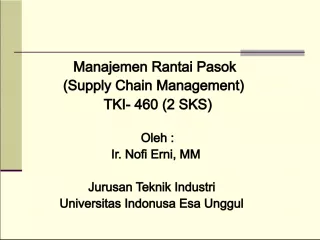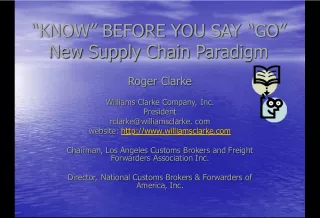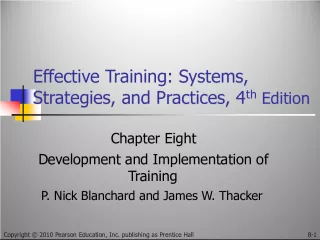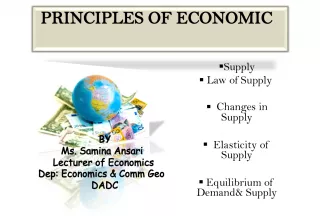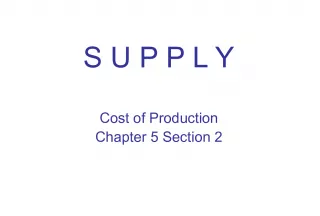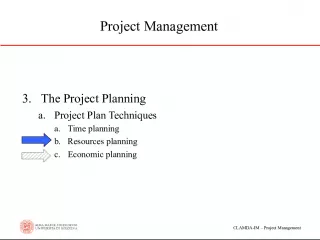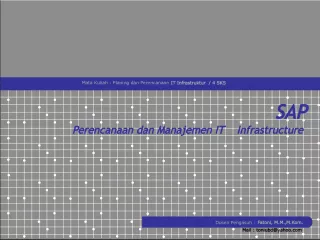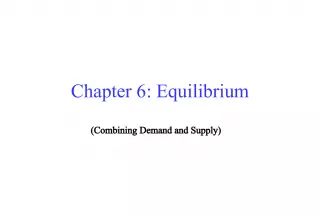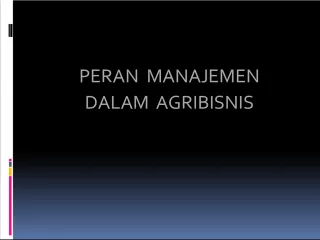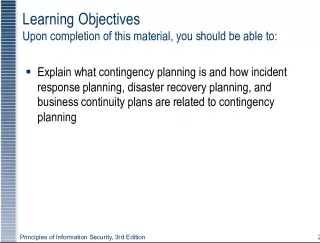Aggregate Planning in Supply Chain Management: Strategies and Implementation
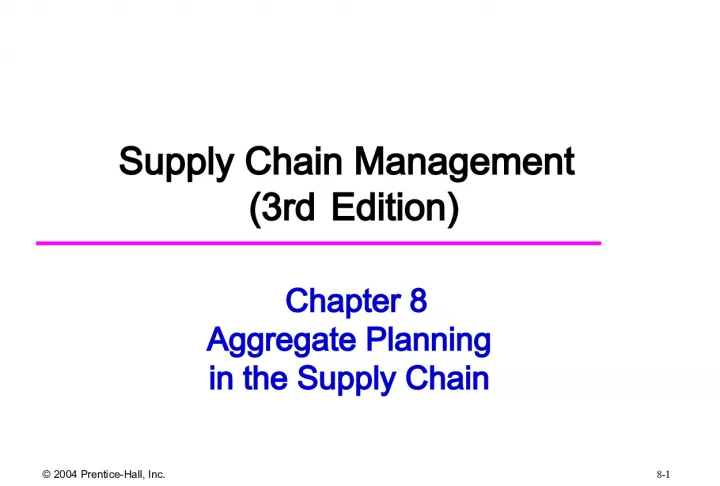

This chapter explores the role of aggregate planning in a supply chain, discussing strategies for capacity, production, inventory, and pricing decisions over a specified time horizon. The goal is to maximize profit while considering cost and lead times.
- Uploaded on | 2 Views
-
 joaquina
joaquina
About Aggregate Planning in Supply Chain Management: Strategies and Implementation
PowerPoint presentation about 'Aggregate Planning in Supply Chain Management: Strategies and Implementation'. This presentation describes the topic on This chapter explores the role of aggregate planning in a supply chain, discussing strategies for capacity, production, inventory, and pricing decisions over a specified time horizon. The goal is to maximize profit while considering cost and lead times.. The key topics included in this slideshow are Aggregate planning, supply chain management, capacity, production, inventory, pricing,. Download this presentation absolutely free.
Presentation Transcript
1. 2004 Prentice-Hall, Inc. 8-1 Chapter 8 Aggregate Planning in the Supply Chain Supply Chain Management ( 3rd Edition)
2. 2004 Prentice-Hall, Inc. 8-2 Outline u Role of aggregate planning in a supply chain u The aggregate planning problem u Aggregate planning strategies u Implementing aggregate planning in practice
3. 2004 Prentice-Hall, Inc. 8-3 Role of Aggregate Planning in a Supply Chain u Imagine a world where all costs and lead times are zero... u However capacity is costly and LTs are not zero.. How to use capacity? When to outsource? u Aggregate planning: process by which a company determines levels of capacity, production, subcontracting, inventory, stockouts, and pricing over a specified time horizon goal is to maximize profit decisions made at a product family (not SKU) level time frame of 3 to 18 months how can a firm best use the facilities it has?
4. 2004 Prentice-Hall, Inc. 8-4 Role of Aggregate Planning in a Supply Chain u Specify operational parameters over the time horizon: production rate workforce overtime machine capacity level subcontracting backlog inventory on hand u All supply chain stages should work together on an aggregate plan that will optimize supply chain performance
5. 2004 Prentice-Hall, Inc. 8-5 The Aggregate Planning Problem u Given the demand forecast for each period in the planning horizon, determine the production level, inventory level, and the capacity level for each period that maximizes the firms (supply chains) profit over the planning horizon u Specify the planning horizon (typically 3-18 months) u Specify the duration of each period u Specify key information required to develop an aggregate plan
6. 2004 Prentice-Hall, Inc. 8-6 Information Needed for an Aggregate Plan u Demand forecast in each period u Production costs labor costs, regular time ($/hr) and overtime ($/hr) subcontracting costs ($/hr or $/unit) cost of changing capacity: hiring or layoff ($/worker) and cost of adding or reducing machine capacity ($/machine) u Labor/machine hours required per unit u Inventory holding cost ($/unit/period) u Stockout or backlog cost ($/unit/period) u Constraints: limits on overtime, layoffs, capital available, stockouts and backlogs
7. 2004 Prentice-Hall, Inc. 8-7 Outputs of Aggregate Plan u Production quantity from regular time, overtime, and subcontracted time: used to determine number of workers and supplier purchase levels u Inventory held: used to determine how much warehouse space and working capital is needed u Backlog/stockout quantity: used to determine what customer service levels will be u Machine capacity increase/decrease: used to determine if new production equipment needs to be purchased !! !! A poor aggregate plan can result in lost sales, lost profits, excess inventory, or excess capacity
8. 2004 Prentice-Hall, Inc. 8-8 Aggregate Planning Strategies Capacity I nventory B acklog/lost sales Costs Costs Costs u Chase strategy using capacity as the lever u Time flexibility startegy using workforce or capacity utilization as the lever u Level strategy using inventory as the lever u Mixed strategy a combination of one or more of the first three strategies
9. 2004 Prentice-Hall, Inc. 8-9 Chase Strategy u Production rate is synchronized with demand by varying machine capacity or hiring and laying off workers as the demand rate varies u However, in practice, it is often difficult to vary capacity and workforce on short notice u Expensive if cost of varying capacity is high u Negative effect on workforce morale u Results in low levels of inventory u Should be used when inventory holding costs are high and costs of changing capacity are low
10. 2004 Prentice-Hall, Inc. 8-10 Time Flexibility Strategy u Can be used if there is excess machine capacity u Workforce is kept stable, but the number of hours worked is varied over time to synchronize production and demand u Can use overtime or a flexible work schedule u Requires flexible workforce, but avoids morale problems of the chase strategy u Low levels of inventory , but lower utilization u Should be used when inventory holding costs are high and capacity is relatively inexpensive
11. 2004 Prentice-Hall, Inc. 8-11 Level Strategy u Maintain stable machine capacity and workforce levels with a constant output rate u No synchronization of demand and supply results in Shortages and surpluses u Inventories that are built up in anticipation of future demand or backlogs are carried over from high to low demand periods u Better for worker morale u Large inventories and backlogs may accumulate u Should be used when inventory holding and backlog costs are relatively low
12. 2004 Prentice-Hall, Inc. 8-12 Ex: Red Tomato Tools u Demand for the gardening tools is highly seasonal. u Handle demand and maximize profits?? u Options: Hire worker in peak season Subcontraction of some work Build up inventory in slow period Backlogging u Constraints: No limit on subcontracting, inventories, stockouts, backlog All stockouts are backlogged from the following month. Inventory costs are incurred on the ending inventory in a month. Inventory level at the end of June is at least 500 units.
13. 2004 Prentice-Hall, Inc. 8-13 Ex: Red Tomato Tools-Demand Forecast
14. 2004 Prentice-Hall, Inc. 8-14 Ex: Red Tomato Tools-Initialization u Unit price=$40/unit u Inventory at the beginning of January=1000 units u Workforce at the beginning of January=80 employees u Total of 20 workdays/month are available u Regular work hours=8hrs/day/employee u Overtime work hours can not exceed 10hrs/month/employee u Required labor hours= 4hrs/unit
15. 2004 Prentice-Hall, Inc. 8-15 Ex: Red Tomato Tools-Costs
16. 2004 Prentice-Hall, Inc. 8-16 Aggregate Planning (Define Decision Variables) W t = Workforce size for month t , t = 1, ..., 6 H t = Number of employees hired at the beginning of month t , t = 1, ..., 6 L t = Number of employees laid off at the beginning of month t , t = 1, ..., 6 P t = Production in month t , t = 1, ..., 6 I t = Inventory at the end of month t , t = 1, ..., 6 S t = Number of units stocked out (backlogged) at the end of month t , t = 1, ..., 6 C t = Number of units subcontracted for month t , t = 1, ..., 6 O t = Number of overtime hours worked in month t , t = 1, ..., 6
17. 2004 Prentice-Hall, Inc. 8-17 ? Min cost = Max profit u Min cost and max profit are equivalent if All demand has to be met in some way The unit price is fixed, i.e., total revenue is fixed. u Then, min cost and max profit gives the same optimal plan.
18. 2004 Prentice-Hall, Inc. 8-18 Aggregate Planning (Define Objective Function)
19. 2004 Prentice-Hall, Inc. 8-19 Workforce Balance Equations u Workforce size for each month is based on hiring and layoffs Period t W t-1 W t H t L t
20. 2004 Prentice-Hall, Inc. 8-20 Inventory Balance Equations Period t I t-1 I t P t D t S t-1 S t C t
21. 2004 Prentice-Hall, Inc. 8-21 Production Capacity Constraints u Production for each month cannot exceed regular+overtime working capacity
22. 2004 Prentice-Hall, Inc. 8-22 Overtime Capacity Constrai nts u Over time for each month
23. 2004 Prentice-Hall, Inc. 8-23 Average Flow Time u Littles Law: Average Flow time=Average Inventory/Throughput Average Flow Time for Red Tomato=895/2,667=0.34 months ?? ?? What happens to Average Flow Time if uncertainty in demand increases?
24. 2004 Prentice-Hall, Inc. 8-24 Scenarios u Increased demand fluctuation u Increase in holding cost (from $2 to $6) u Overtime cost drops to $4.1 per hour
25. 2004 Prentice-Hall, Inc. 8-25 Increased Demand Fluctuation
26. 2004 Prentice-Hall, Inc. 8-26 Aggregate Planning in Practice u Think beyond the enterprise to the entire supply chain u Make plans flexible because forecasts are always wrong u Rerun the aggregate plan as new information emerges u Use aggregate planning as capacity utilization increases
27. 2004 Prentice-Hall, Inc. 8-27 Summary of Learning Objectives u What types of decisions are best solved by aggregate planning? u What is the importance of aggregate planning as a supply chain activity? u What kinds of information are needed to produce an aggregate plan? u What are the basic trade-offs a manager makes to produce an aggregate plan? u How are aggregate planning problems formulated and solved using Microsoft Excel?

